
Ben Franklin: Captain's Log
Ben Franklin
Gulf Stream Drift Mission Report
Grumman Aerospace Corporation
Ocean Systems Department
Document OSR-69-19

Ben Franklin: Captain's Log
Ben Franklin
Gulf Stream Drift Mission Report
Grumman Aerospace Corporation
Ocean Systems Department
Document OSR-69-19
The following is a very condensed version of the Captain's Log
written by Captain Don Kazimir and published in the
Ben Franklin Gulf Stream Drift Mission Report,
describing how the mission progressed day-by-day and
highlighting some of the most significant events.
The hand-drawn figures were part of the very detailed
and lavishly illustrated logbook kept by Erwin Aebersold,
engineer and pilot onboard Ben Franklin.
14 July 1969
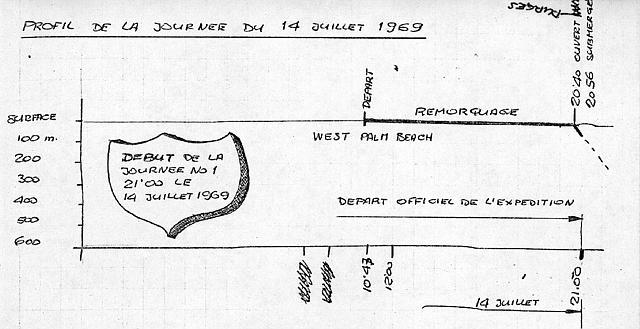 >
>
At 1025 hours the "Ready for Sea" checkout was completed. It
was hoped the BEN FRANKLIN could leave port quietly with
little fanfare; however, quite a crowd was on hand. The BEN
FRANKLIN got underway at 1043 hours and passed the sea buoy
at 1123 hours with only H. Dorr and D. Kazimir aboard to prepare
the boat for diving. The remainder of the crew was aboard the
M/V PRIVATEER. At 1635 hours, the LiOH was deployed. We
were on station at 1844 hours, waiting for the boat DRAGON
LADY with additional LiOH panels that arrived after FRANKLIN
was underway. At 2030 hours, the hatch was secured with the
crew aboard. "Rig for Dive" was completed, and both VBT's were
empty. At 2056 hours, the main ballast tank vents were opened -
diving (Dive number 41). The boat descended smoothly - dribbled
shot occasionally to slow descent. Trim good, no propulsion
needed. At 2150 hours, we bottomed in 510 meters of water.
Commenced checking boat and NAVOCEANO equipment.
NAVOCEANO gear working well except transmissometer, sub
bottom profiler, and magnetometer. Side scan sonar will not
operate due to high voltage provided by ships batteries. It was
estimated that it would take a few days before the voltage was less
than 30 volts.
15 July 1969 (day 1)
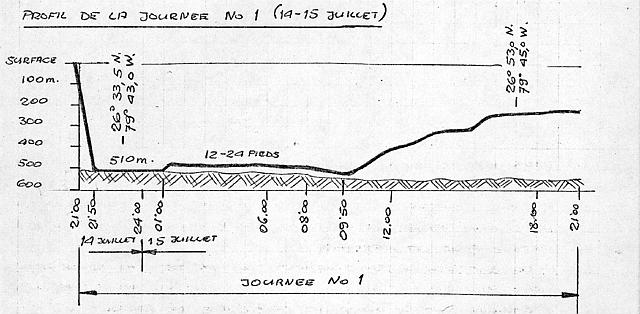
The checks were completed at 0100 hours; all hands settled down.
Commenced dribbling the shot to achieve neutral buoyancy at
20-ft altitude. The BEN FRANKLIN was underway drifting north
in the Gulf Stream at 0119 hours; visibility good but the current
was quite slow. Sonar in standby when not in use. One landing
light used for forward visibility. At 0150 hours noticed a slight
air leak in the air reducer and tightened the plug but it still leaked
(very slightly) so it was decided to secure all air flasks. During
this period, a few output fuses blew in the auxiliary 60-cps
inverters due to operator error (too much load on the inverter).
Also discovered a slight hydraulic leak around the valve stem of
the depth gage. The bonnet was tightened and the leak stopped; At
0500 hours, we were drifting very slowly; the boat was getting
colder and colder. We dribbled shot occasionally to account for
hull shrinkage as the boat cooled down. At 0900 hours, our
position was about 19°, 19 miles from Palm Beach Inlet. Decided
to terminate bottom cruise due to slow drift speed. Began ascent
to 600 ft by dribbling shot. At 1135 hours, noticed a small drip at
NAVOCEANO's penetrator in H-6 (This penetrator dripped
occasionally during the 30 days. It was very slight and usually
dry). Penetrator tightened. During the 1200 hour routine checkoff,
Drager CO2 gage failed; shifted to the Fyrite gage, which worked
well throughout the 30 days. Lost communications with
PRIVATEER at 1420 hours; had to use new 504 unit (underwater
telephone) at full power to regain communications. Evidently, the
PRIVATEER trackers lost us. Range checks were used to regain
position. The Straza 504 paid for itself already. At 1500 hours,
we achieved neutral buoyancy at 300 meters with both VBT's
(variable ballast tanks) empty. The cabin temperature was still
about 55° F, but gradually rising. During this depth change, the
current occasionally came from the north. For these first 2 days,
everyone was quite busy with very little sleep; however, spirits
were quite high.
16 July 1969
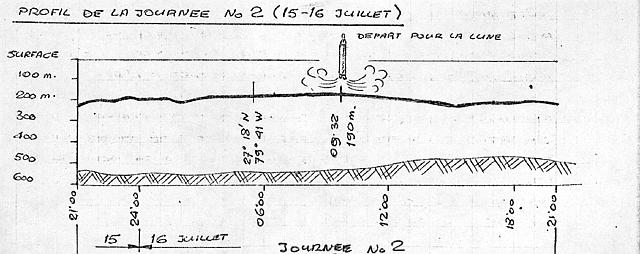
We were drifting nicely at 200 meters. The ampere-hour system
was in operation; however, the B-2 counter occasionally counted
rapidly for no apparent reason. F. Busby, D. Kazimir, C. May,
and J. Piccard have slight colds. The cabin temperature got up to a
comfortable 66 °F. C. May checked iodine concentration in the
number 1 and 2 fresh water tanks and found no iodine - cannot
understand why, the concentration should be 6 ppm. The same
for tanks 3 and 4. C. May was having difficulty with the bunk
counters and some sleep monitoring caps. The number 1 hot
water tank was cooling down fast since the vacuum was lost -
will shift tanks soon. Good luck message was sent to Apollo 11
astronauts.
17 July 1969
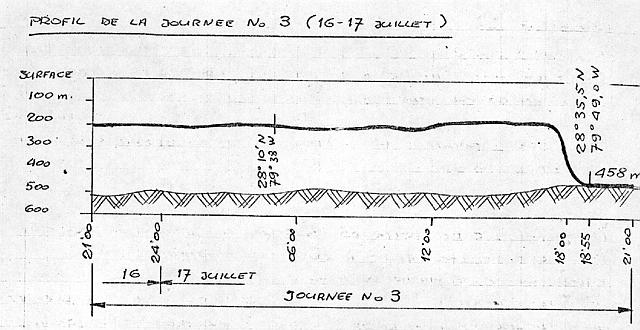
We were drifting at approximately 200 meters. Took the first set
of battery ground readings at 0810 hours; they looked fine. The
macerator needed repairs; it wouldn't stop running, so we had to
defuse it. C. May and K. Haigh found a ground on the case and
corrected it. At 1030 hours we deployed the LiOH panels. The
motors were meggered at 1530 hours; they looked fine. The
boat seems to drift with the stern pointing north. She oscillates a
little to either side and occasionally turns around. Began the
descent to the bottom at 1705 hours by flooding the port VBT in
increments. At 1800 hours; the compass was found to be
unreliable; shifted to the portable compass (This compass worked
well throughout the mission). At 1855 hours; we bottomed in
458 meters after sitting on the guide rope and gradually reached
the bottom as the hull cooled. Measured the current speed; which
was quite slow; less than 0.2 knots; At 2036;
we blew the port VBT slightly to ascend to cruise depth - about
20 ft off the bottom. Sat on the guide rope waiting for the current
to push us; but to no avail ~ the current was too slow´ The
Privateer dropped 50 blasting caps for acoustic studies. The drift
rehearsal now over - we will go for 30 days.
18 July 1969

At 0112 hours; a slow ascent was begun by blowing the port
VBT in increments. The stern 250-watt light was used mainly for
observations at shallow depth - it attracts quite a bit of plankton.
At 0609 hours; two swordfish were observed at the aft hemisphere
swimming around rapidly. Once actually attacked the viewport
that F. Busby was using. At 0900 hours; (at 200 meters) the
humidity went up to 82%; and more silica gel was deployed, This
reduced the level to a satisfactory 75%. Coricidin pills helped in
reducing our cold symptoms. Each day we computed power usage
based on the equipment logs and compared with the actual usage;
however; wide variations existed. We will secure the ampere-hour
system when the computed method becomes accurate.
19 July 1969
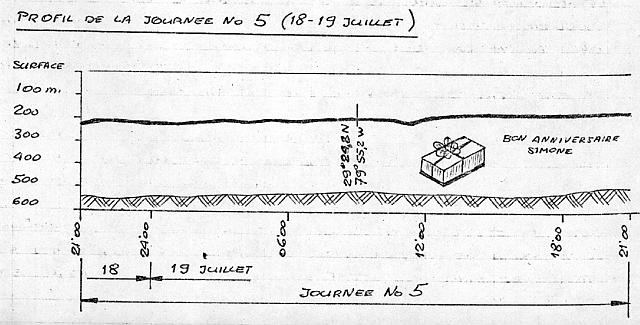
We were drifting routinely at approximately 230 meters; our
position was 60 miles NE of New Smyrna Beach; Florida. At
1450 hours; at 187 meters; we secured all lights to check light
level. Large print can be read easily. At 2014 hours; we changed
the LiOH panels (we were averaging about 3 days per set of 12).
The Egan Experiment was working well except for
bioluminescence. The boat continues to be very stable at depth.
20 July 1969

We were drifting along nicely at 170 meters. We discovered some
carbon monoxide (10 ppm) and a small amount of hydrazine and
acetone during our routine checks with the Drager tubes. The four
-main and four positioning motors meggered out OK. We had to
flood some water in the starboard VBT as the depth decreased to
142 meters. The communications with PRIVATEER have been
excellent. K. Haigh completed the seismic studies with LYNCH
supplying the SUS charges. The highlight of the day was the
moon landing as reported by the PRIVATEER.
21 July 1969
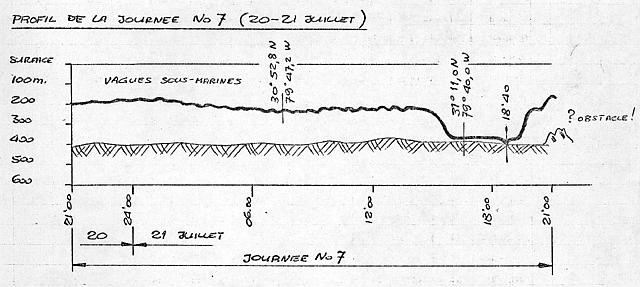
We continued drifting at approximately 190 meters. Our position
was 90 miles east of Brunswick, Georgia. We commenced another
set of SUS charges at 1340 hours for acoustic tests. At 1414
hours we began the descent to the bottom by flooding the
starboard VBT in increments. By 1555 we were cruising at the
20--ft altitude in a depth of 372 meters. The current was quite
strong. At 1830 hours, we bottomed briefly to measure the
current using our motors to hold position. At 1850; we were
cruising at the 30-ft altitude. We spotted multiple sonar targets
and ascended to 100-ft altitude. Decided to remain well above the
bottom and then take another look at 0200 hours. We detected the
first bacterial contamination, using endo and total media in Petri
dishes at the head sink. The Grumman movie camera
malfunctioned while attempting to photograph the bottom.
22 July 1969
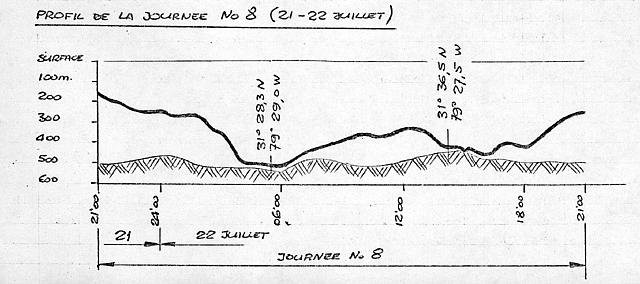
Drifting at 260 meters; commenced descent at 0150 hours. At
0415, at 70-ft altitude, conducted acoustic test using blasting caps
which were released from the surface vessel. At 0500 hours we
were cruising close to the bottom at a good speed, operating the
sonar continuously. The bottom was hard and bumpy with some
small escarpments seen. At 0600, we commenced ascent to a
shallower depth. It would be better to study this area in three
separate excursions during a 24-hr period due to the physical
strain, cold, and high-power usage. At 1400 hours, we conducted
another 1-hour bottom cruise in conjunction with the seismic
studies. Discovered the B-2 counter (This counter in the
ampere-hour system monitored the power used from the B-2
battery string) was malfunctioning; decided to rely on the
computed power figures for the 110-vdc load. The ocean bottom
In this area was fairly interesting. The effects of internal waves
caused large, slow depth changes.
23 July 1969
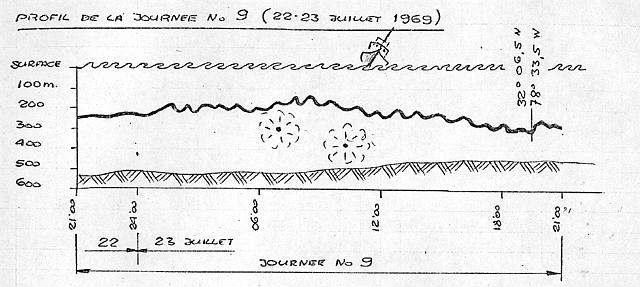
Today we were drifting at 200 meters, about 100 miles east of
Charleston, South Carolina. For a short period, internal waves
were noted at 1000 hours. The boat sometimes changes depth of
40 meters in wave periods of 15 minutes. At the end of the day,
decided to secure ampere-hour system and rely on equipment logs
to compute the power usage (saves power).
24 July 1969

At approximately 200 meters today. We were having fits again
due to internal waves. The boat oscillated between 180 and 220
meters. Changed the bacteria fillers and replaced the purafil in the
head blower. Had to drain some fresh water into the mini-waste
tank for flushing. The sinks were clear of contaminants - possibly
due to changing of the bacteria filters. The mission has gone well
- the crew and boat in good shape.
25 July 1969
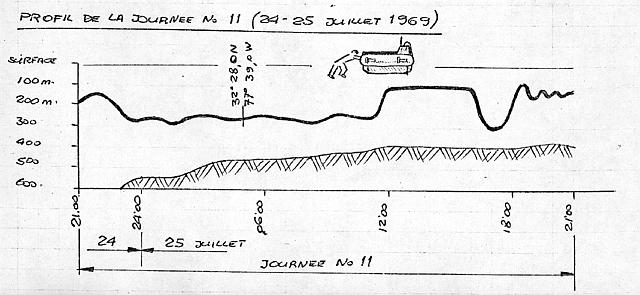
Drifting at 270 meters approximately 90 miles south of Cape
Fear, North Carolina. Motors meggered OK at 1112 hours. At
1123 hours; PRIVATEER reported that we broke through the
north wall of the Gulf Stream; we then commenced running on
two motors at 60 amps to power back into the Stream, on a
course of 100°. At 1705 hours; we completed the transit. Today
we observed endo and total contamination of water at the head
sink.
26 July 1969
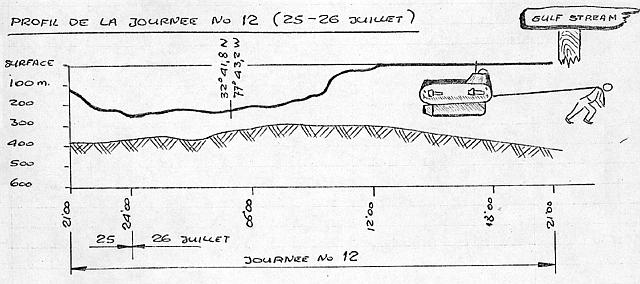
At 233 meters at 0400 hours, it was quite clear that we did not
make our way back into the Stream´ At 0928 hours; we
commenced the ascent to the surface. The decision was made to
have PRIVATEER tow FRANKLIN. We ascended slowly in order
to prevent battery gas from escaping too fast. We saw many
sharks and a barracuda enroute to the surface. We also heard gas
escaping boat got quite warm while on the surface and the sea was
calm. The boat was left sealed during the surfacing and towing in
order not to disturb the "closed environment" which was
important to the NASA study.
27 July 1969
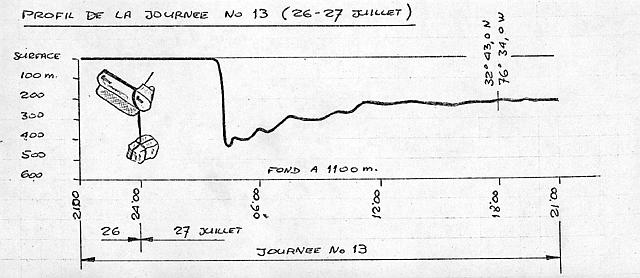
At 0313 hours; FRANKLIN arrived at the dive site in the Gulf
Stream core. Divers re-rigged the noise boom. removed the
magnetometer and disconnected the tow line. Dive number 42
commenced at 0401 hours. FRANKLIN submerged rapidly while
shot was dribbled to slow the descent. Several battery vent valve
salt water sensors came "ON". It took several hours for the boat
to stabilize in the temperature and she finally settled out at
approximately 200 meters at about noon. Megger readings taken
in the evening showed quite a drop for the number 2 main motor
but the reading is still OK. At this point in the mission two crew
members picked up a rash probably due to perspiration and the
fact that underwear was changed every 3 days (not often enough).
The carbon monoxide level was now up to 15 ppm. The acetone
and hydrazine levels had not increased.
28 July 1969
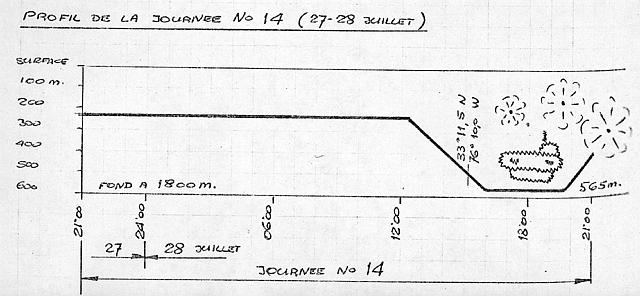
We drifted today quite nicely at 200 meters. High bacteria counts
throughout the boat necessitated a thorough wash down with
microguard. Also, a routine setup to wash down the galley a
shower and head areas daily was instituted. At 1222 hours we
began the descent to 565 meters to measure the ambient light and
to conduct acoustic tests for mid-water scatterers and bottom
reflectivity. Commenced the ascent at 1944 hours. The boat was
very stable no internal waves. F, Busby and E. Aebersold repaired
the wobbly wardroom table with two C-clamps. one "Vise Grip"
and two butter knives for shims.
29 July 1969
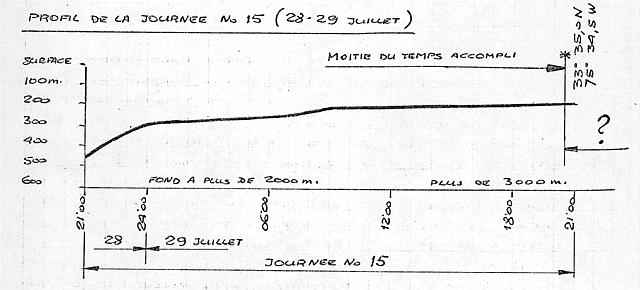
Drifting at shallow depths approximately 85 miles SSE of Cape
Lookout, North Carolina. We passed the halfway point in the
mission at 2030 hours.
30 July 1969
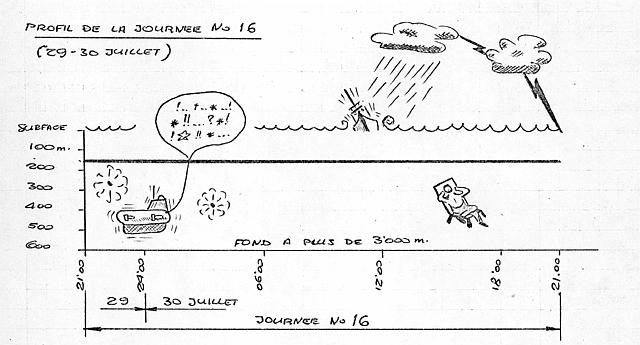
Drifting at 165 meters. The boat was rising slowly. The carbon
monoxide level was up to 20 ppm. We ran the contaminant
removal system for 1 hour. The mission was getting to be quite
routine now with plenty of sleep for everyone.
30 July 1969
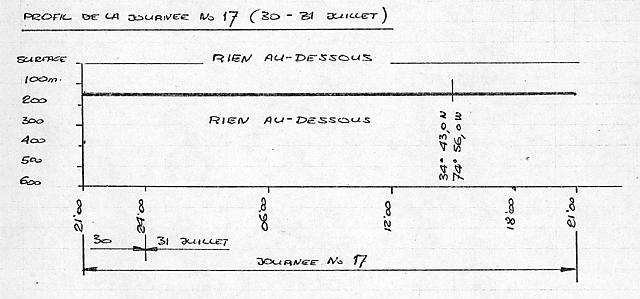
Today we drifted at shallow depths. We went past Cape Hatteras
and headed out to the open sea. The hot water was heated for 2. 5
hours in tank number 3.
1 August 1969
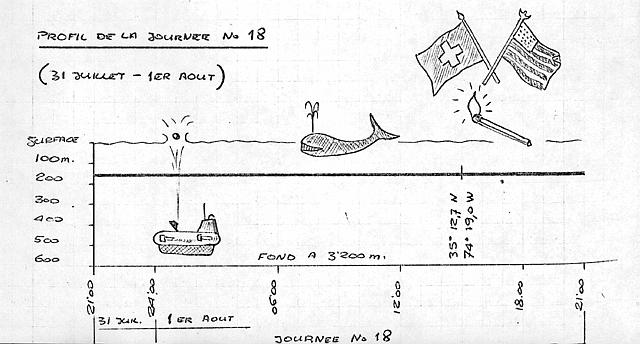
Again we drifted at shallow depths approximately 35 miles east of
Cape Hatteras. At 2055 hours we released a SAS ball with urine
and feces samples in it. The ball was retrieved immediately by
PRIVATEER. Surprise for someone if it wasn't retrieved. The
galley, shower, and head faucets all show contamination This is
no problem since cold water was used only for washing.
2 August 1969
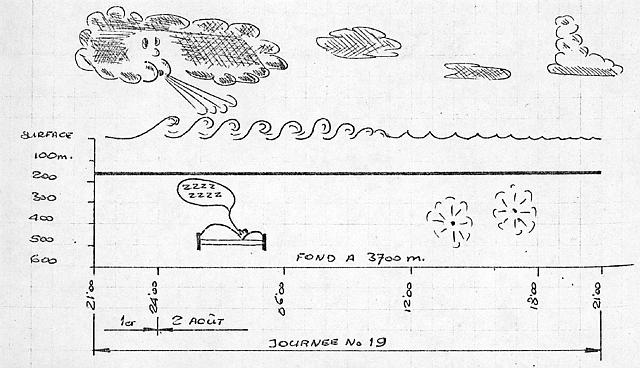
Drifting again at shallow depths today. Motor number 2 meggered
~ holding steady at 5 megohms. Had to heat the hot water for 2. 5
hours; The carbon monoxide level was at 20 ppm, Swiss National
Day was celebrated yesterday (August 1st) by lighting a match in front
of the United States and Swiss flags.
3 August 1969
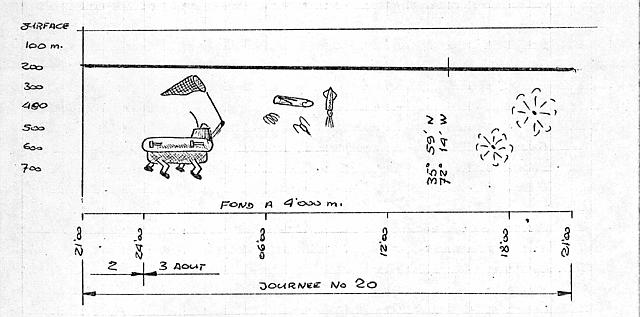
Approximately 120 miles east of Cape Hatteras; we drifted at
shallow depths. Our drift speed has increased to close to 3 knots.
J. Piccard caught a salp in the plankton sampler.
4 August 1969
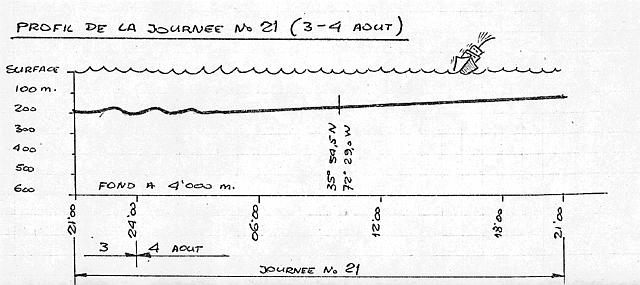
At approximately the 200-meter depth, we drifted 300 miles south
of Block Island. Internal waves made life interesting. The drift
speed was up to 3 knots Plenty of power available as the batteries
continue to hold up well.
5 August 1969
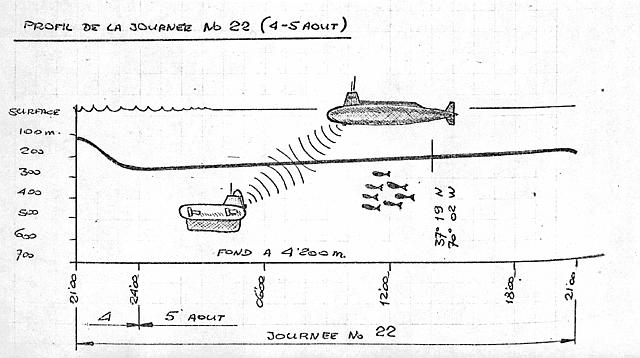
Drifting at shallow depths (200 meters) again at a good speed
approximately 270 miles south of Martha's Vineyard, During the
day, many tuna were sighted. The USS LAPON (SSN661)
transited the area on the surface, FRANKLIN and PRIVATEER
had underwater phone contact with her as she passed through the
area. The carbon monoxide level was up to 30 ppm; ran the
contaminant removal system for 4 hours, Drager readings before
and after running the system indicated no change in the level,
6 August 1969
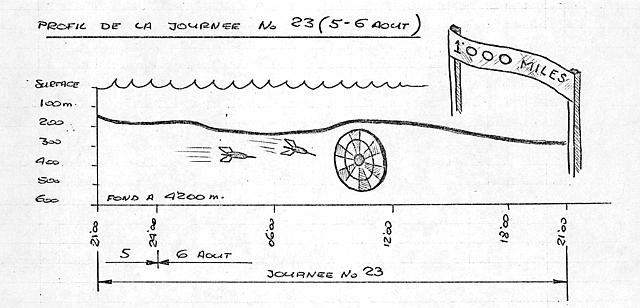
Again drifted at shallow depths approximately 165 miles south of
NANTUCKET SHOALS LIGHTSHIP; Had difficulty blowing
the starboard VBT for depth-keeping - the lines seemed to be
plugged. Cleared the system by building air pressure up to 10
atmospheres over sea pressure. Many whales and porpoises have
been heard on sonar for past few days. Internal waves continue to
plague us; however, the experience level in trimming the boat has
increased to a point where it is no problem. Ran the contaminant
removal system for 4 hours . The carbon monoxide level was at
30 ppm.
7 August 1969
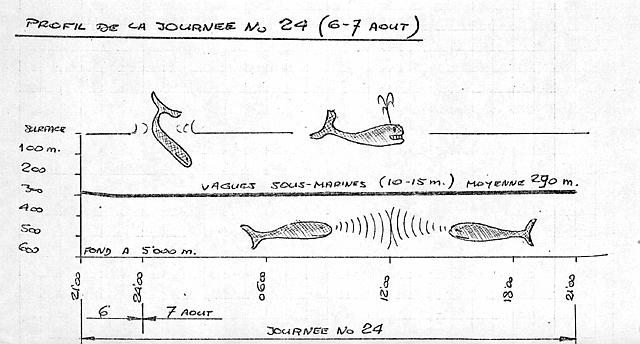
Drifted at 298 meters, moving up and down with no need for
accurate depth keeping. Our position is now about 195°, 320
miles from Cape Sable, Nova Scotia, Heated hot water tank
number 3 for 8 hours. Ran the contaminant removal system again
for 4 hours.
8 August 1969
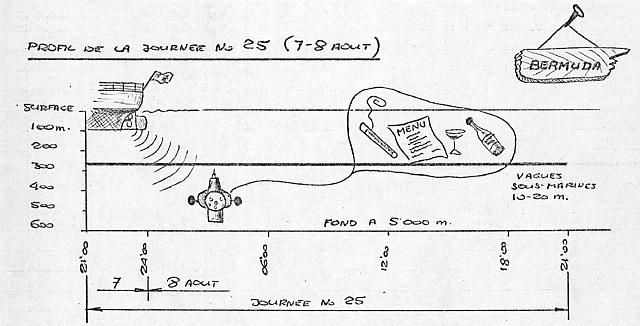
Proceeded nicely at shallow depths at a good speed. Meggered the
motors - all OK. The batteries are in good shape also.
9 August 1969
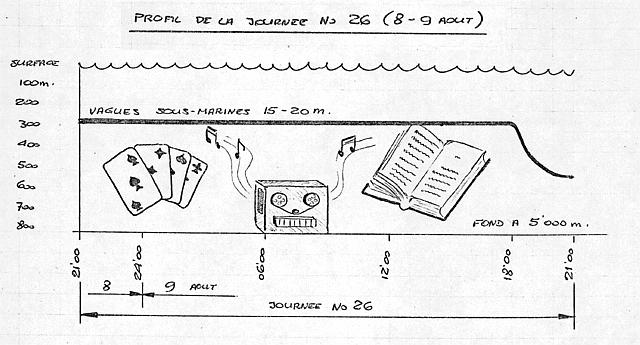
Drifted at 265 meters. At 1811 hours, commenced the descent to
500 meters. At this level, conducted acoustic work using SUS
charges. Vibrations could be felt through the hull even though the
charges were set to explode at 60 ft.
10 August 1969
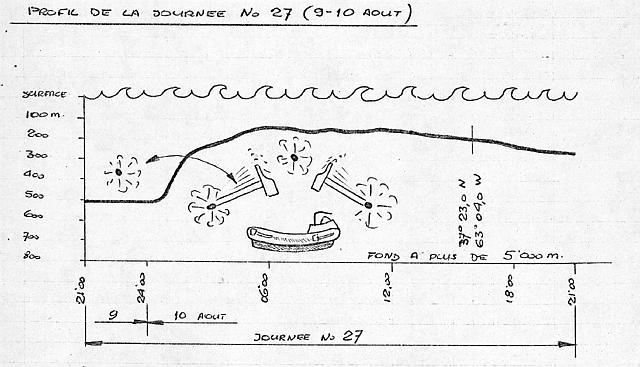
Drifted at 500 meters. Completed the deep excursion at 0030
hours. The carbon monoxide level was up to 40 ppm. The crew is
getting restless. We still have not seen the deep scattering layer´
11 August 1969
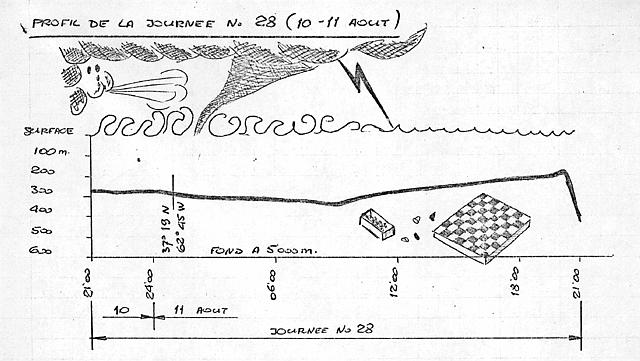
Again drifted at shallow depths. Our speed slowed to less than 2
knots. At 2007 hours commenced the descent to 500 meters for
acoustic work.
12 August 1969
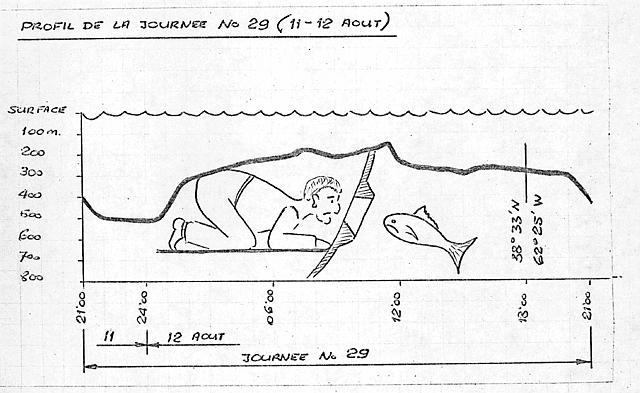
Conducted acoustic experiments at 500 meters. Commenced return
to shallow depths at 0028 hours. The macerator switch burned
out; the system can be used without the macerator. Heated the hot
water tank number 3. The crew has channel fever - quite anxious
to surface. Conducted another descent to 500 meters, commencing
at 2017 hours. Ran the contaminant removal system for 4 hours/
13 August 1969 (day 30)
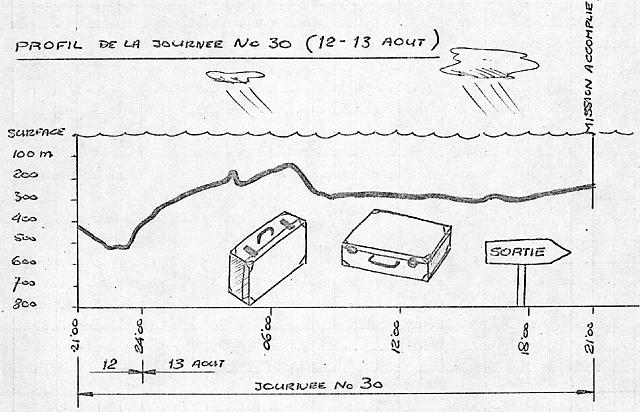
Today we drifted routinely at 408 meters ascending to shallow
depths. We checked the number 2 motor and it meggers OK. The
carbon monoxide level was at 40 ppm. Commenced preparations
for surfacing. The Coast Guard Cutter COOK INLET, arrived and
will standby in order to transport personnel to Portland, Maine.
Since no deep scattering layer was found during the drift, BEN
FRANKLIN will surface with excess power available.
14 August 1969
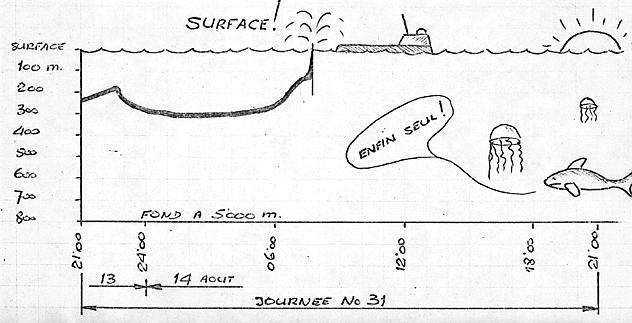
Drifted at 288 meters while preparations continued for surfacing.
The boat was rigged for heavy weather, all data packaged for
transfer to COOK INLET. Commenced slow ascent at 0432 hours
and surfaced at 0757 hours. LYNCH, COOK INLET,
PRIVATEER, two vessels from WHOI, and two rubber boats
stood by. The crew and data was transferred to the COOK INLET.
FRANKLIN was taken in tow by the PRIVATEER after the
PRIVATEER received fuel and provisions from LYNCH.
gene carl feldman (gene@seawifs.gsfc.nasa.gov) (301) 286-9428